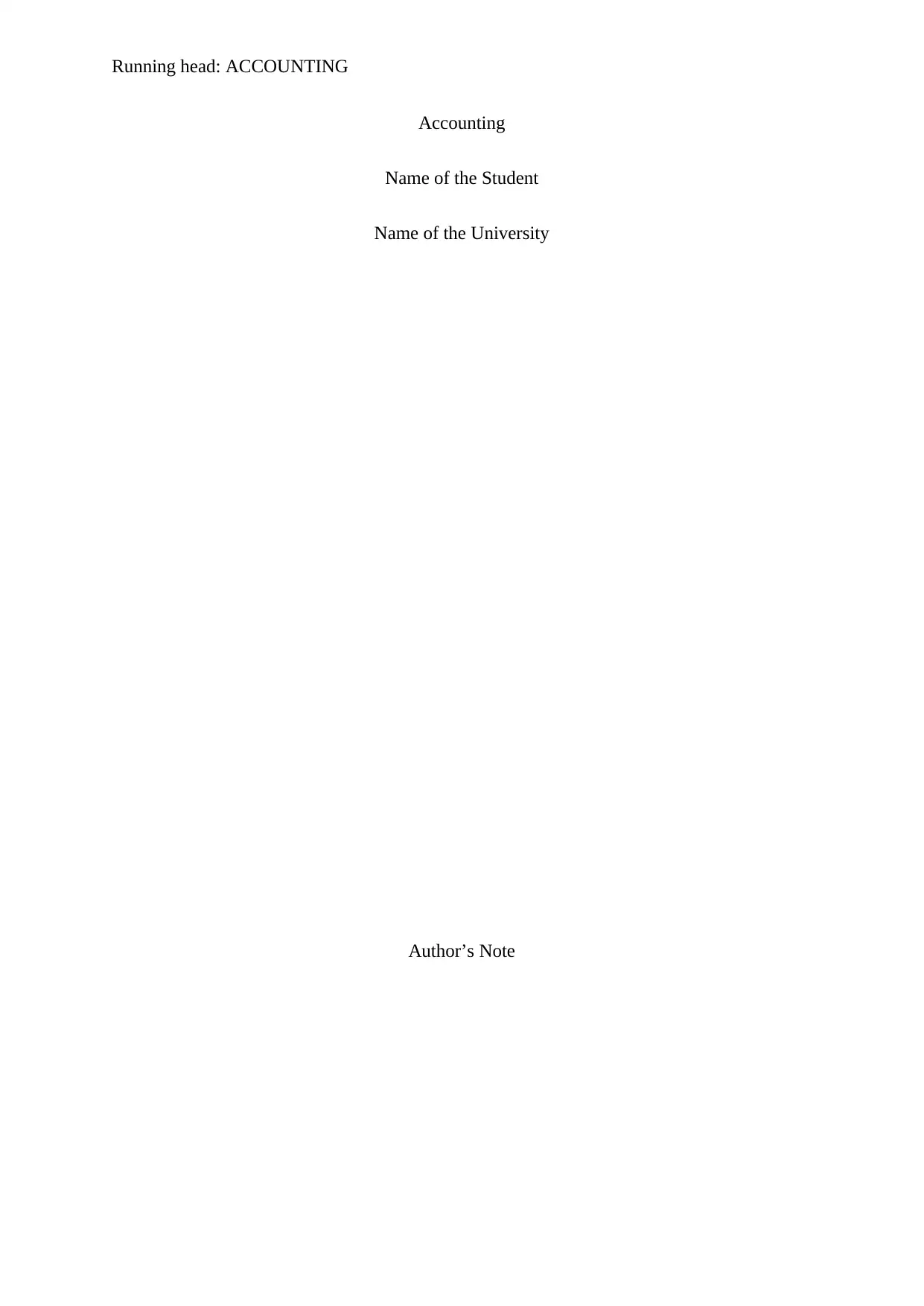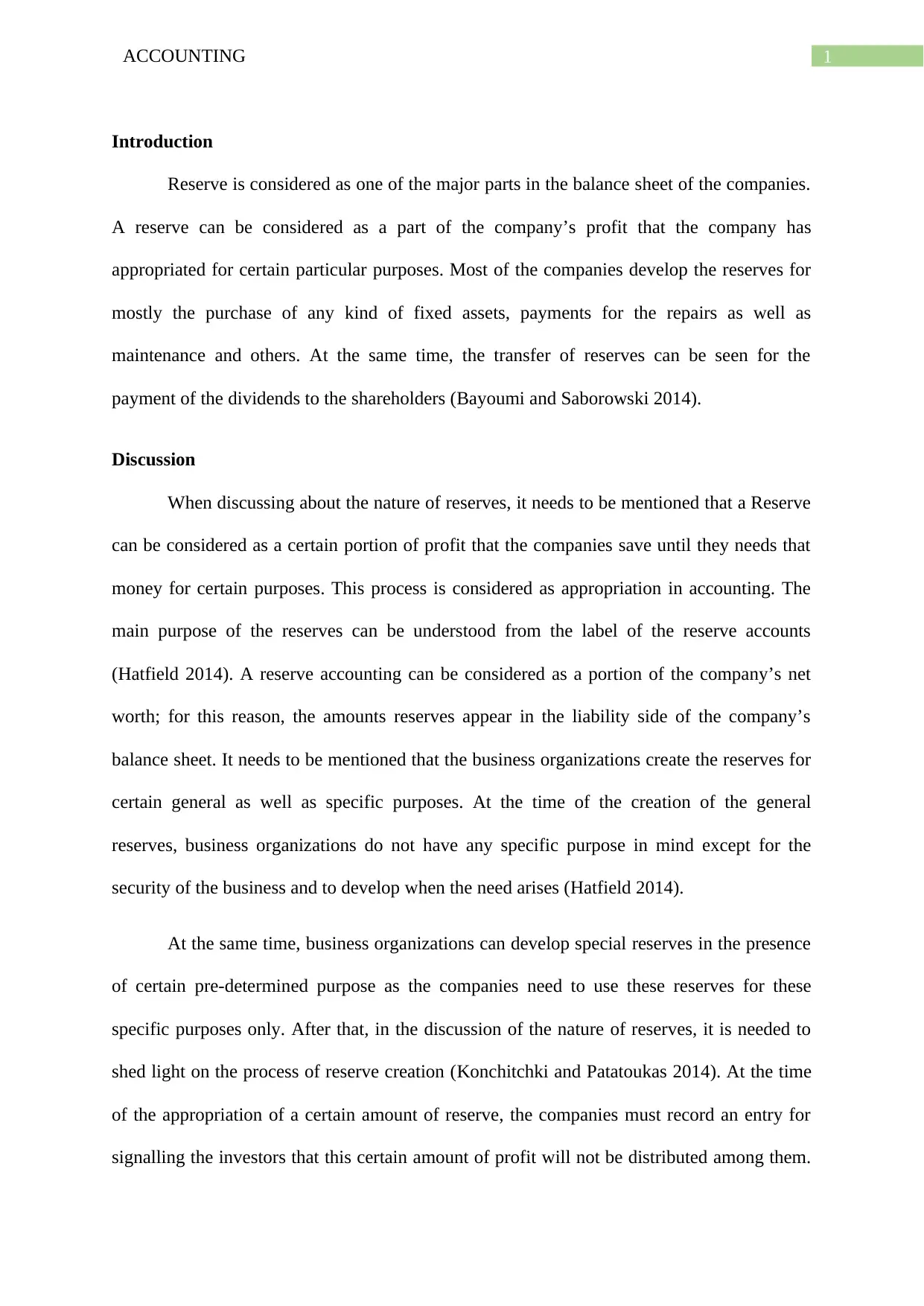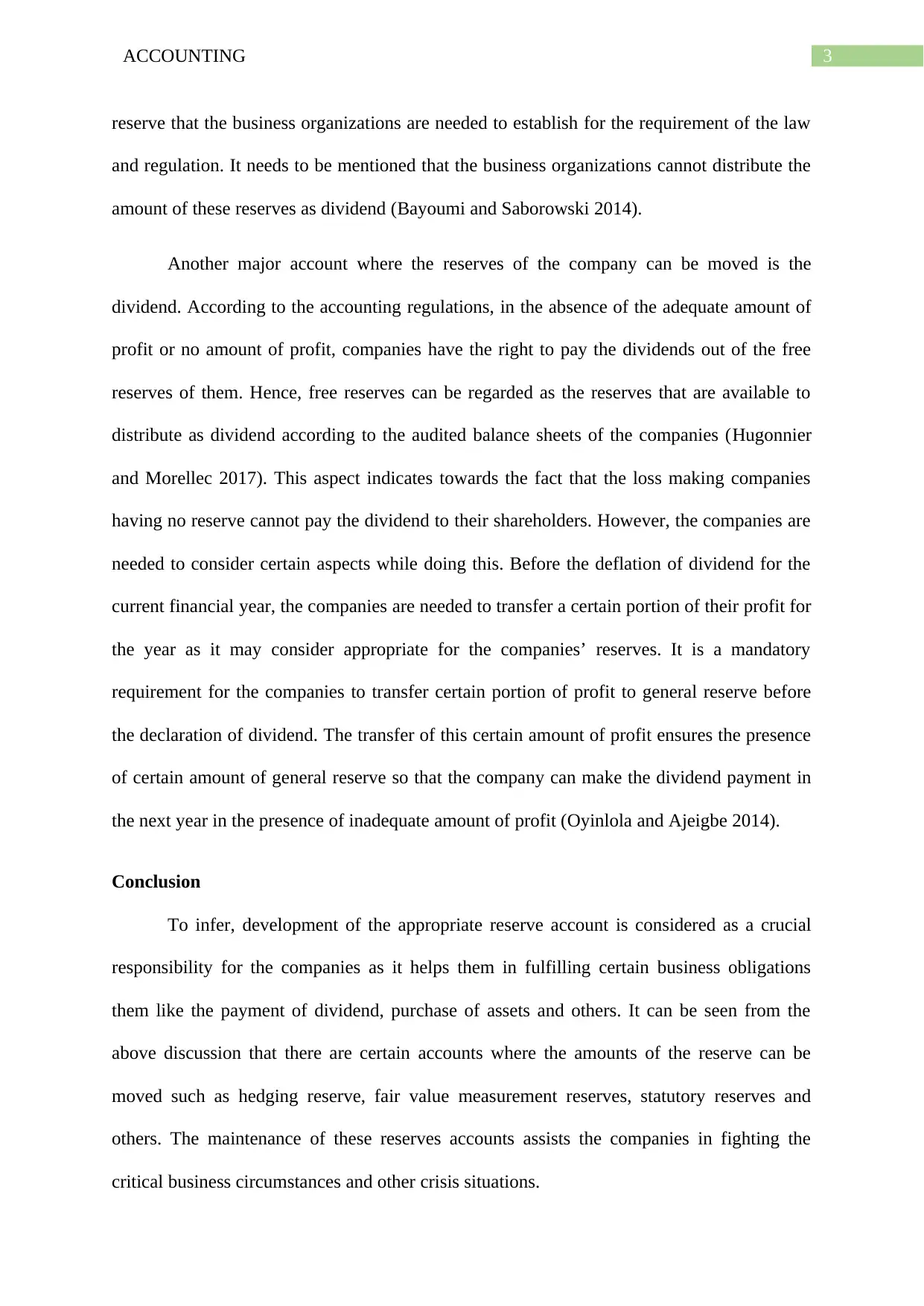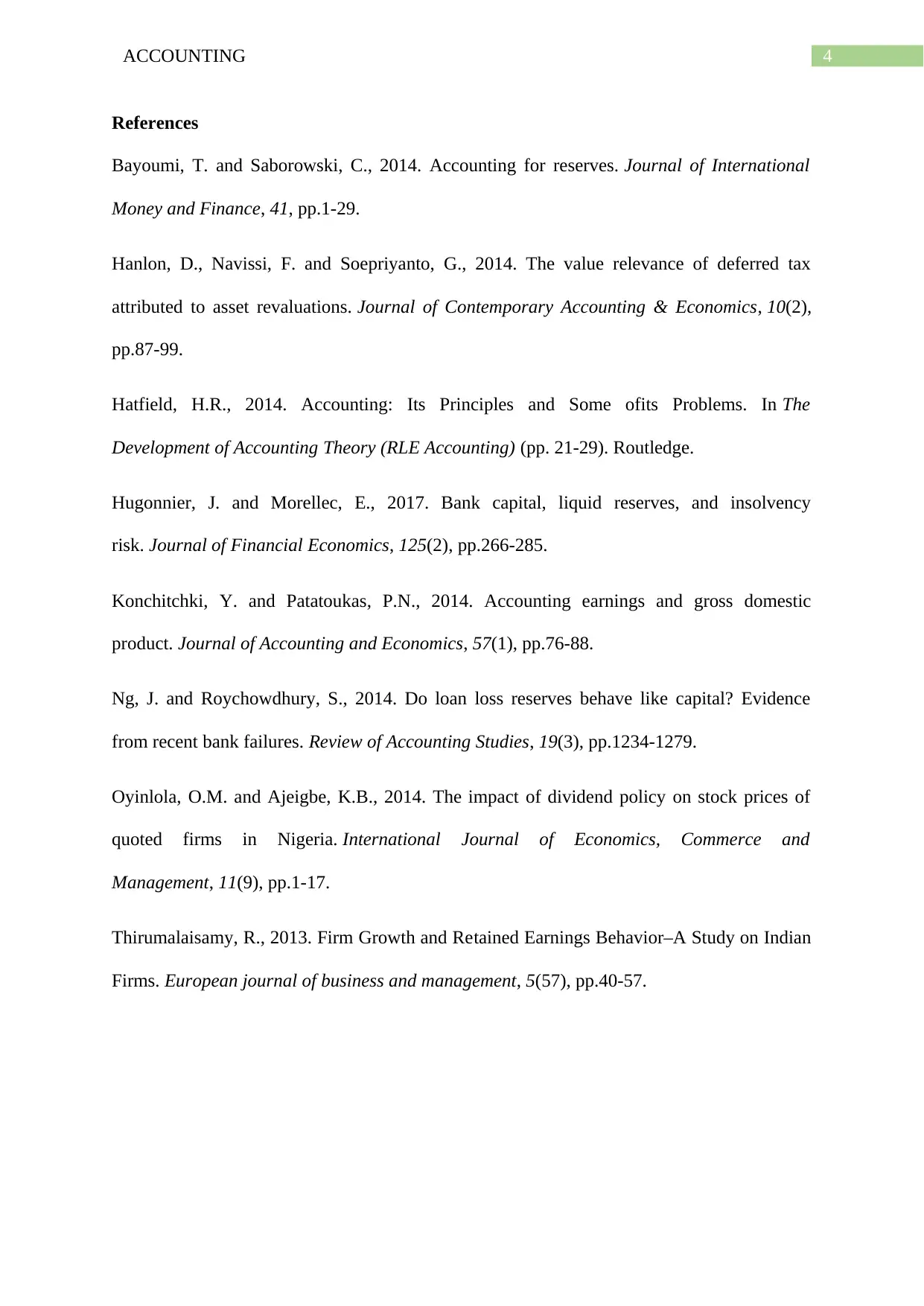A Comprehensive Analysis of Accounting Reserves: Nature and Transfer
VerifiedAdded on 2023/04/25
|5
|1405
|280
Essay
AI Summary
This essay provides a detailed overview of accounting reserves, emphasizing their nature, creation, and transfer processes. It highlights that reserves are a portion of a company's profit allocated for specific purposes such as purchasing fixed assets, covering repairs, and paying dividends. The discussion covers general and specific reserves, the accounting entries required for their creation, and the various accounts to which reserves can be transferred, including Capital Reserve, Retained Earnings, Fair Value Reserve, Hedging Reserve, Asset Revaluation Reserve, Foreign Currency Translation Reserve, and Statutory Reserve. The essay also addresses the use of free reserves for dividend payments, especially in situations where a company lacks sufficient current profits. It concludes by underscoring the importance of maintaining appropriate reserve accounts to meet business obligations and navigate critical financial situations. Desklib offers this essay as a study resource, along with many other solved assignments.

Running head: ACCOUNTING
Accounting
Name of the Student
Name of the University
Author’s Note
Accounting
Name of the Student
Name of the University
Author’s Note
Paraphrase This Document
Need a fresh take? Get an instant paraphrase of this document with our AI Paraphraser

1ACCOUNTING
Introduction
Reserve is considered as one of the major parts in the balance sheet of the companies.
A reserve can be considered as a part of the company’s profit that the company has
appropriated for certain particular purposes. Most of the companies develop the reserves for
mostly the purchase of any kind of fixed assets, payments for the repairs as well as
maintenance and others. At the same time, the transfer of reserves can be seen for the
payment of the dividends to the shareholders (Bayoumi and Saborowski 2014).
Discussion
When discussing about the nature of reserves, it needs to be mentioned that a Reserve
can be considered as a certain portion of profit that the companies save until they needs that
money for certain purposes. This process is considered as appropriation in accounting. The
main purpose of the reserves can be understood from the label of the reserve accounts
(Hatfield 2014). A reserve accounting can be considered as a portion of the company’s net
worth; for this reason, the amounts reserves appear in the liability side of the company’s
balance sheet. It needs to be mentioned that the business organizations create the reserves for
certain general as well as specific purposes. At the time of the creation of the general
reserves, business organizations do not have any specific purpose in mind except for the
security of the business and to develop when the need arises (Hatfield 2014).
At the same time, business organizations can develop special reserves in the presence
of certain pre-determined purpose as the companies need to use these reserves for these
specific purposes only. After that, in the discussion of the nature of reserves, it is needed to
shed light on the process of reserve creation (Konchitchki and Patatoukas 2014). At the time
of the appropriation of a certain amount of reserve, the companies must record an entry for
signalling the investors that this certain amount of profit will not be distributed among them.
Introduction
Reserve is considered as one of the major parts in the balance sheet of the companies.
A reserve can be considered as a part of the company’s profit that the company has
appropriated for certain particular purposes. Most of the companies develop the reserves for
mostly the purchase of any kind of fixed assets, payments for the repairs as well as
maintenance and others. At the same time, the transfer of reserves can be seen for the
payment of the dividends to the shareholders (Bayoumi and Saborowski 2014).
Discussion
When discussing about the nature of reserves, it needs to be mentioned that a Reserve
can be considered as a certain portion of profit that the companies save until they needs that
money for certain purposes. This process is considered as appropriation in accounting. The
main purpose of the reserves can be understood from the label of the reserve accounts
(Hatfield 2014). A reserve accounting can be considered as a portion of the company’s net
worth; for this reason, the amounts reserves appear in the liability side of the company’s
balance sheet. It needs to be mentioned that the business organizations create the reserves for
certain general as well as specific purposes. At the time of the creation of the general
reserves, business organizations do not have any specific purpose in mind except for the
security of the business and to develop when the need arises (Hatfield 2014).
At the same time, business organizations can develop special reserves in the presence
of certain pre-determined purpose as the companies need to use these reserves for these
specific purposes only. After that, in the discussion of the nature of reserves, it is needed to
shed light on the process of reserve creation (Konchitchki and Patatoukas 2014). At the time
of the appropriation of a certain amount of reserve, the companies must record an entry for
signalling the investors that this certain amount of profit will not be distributed among them.

2ACCOUNTING
After the deciding the amount that the company needs to save, they need to create the reserve
account by debiting retain earnings and crediting the general or specific reserve accounts.
Retained earnings can be regarded as the undistributed profits (Konchitchki and Patatoukas
2014).
Transfer of reserve is considered as a major part in the process of reserve accounting
for the business organizations. It can be seen that the business organizations use to transfer
their reserves in different accounts. One of these accounts is the Capital Reserve account and
the development of this can be seen due to the result of issuing shares of stocks in excess of
their per value (Ng and Roychowdhury 2014). This is considered as an important account for
transferring reserve. Retained earnings is considered as another account and this arises due to
the presence of any past profitable operations. Retained earnings are the portion of net profits
that the company has not distributed to the shareholders as dividend (Thirumalaisamy 2013).
After that, Fair Value Reserve is considered as another account where reserve is transferred
and this reserve include adjustments for the assets and securities that are available for sales.
This reserve is essential for the businesses like property and casualty insurance and others.
After that, the account of Hedging Reserve can be seen for the transfer of reserve and the
development of this reserve can be seen as a result of hedges of the company for the
protection against volatility and others.
Another account is Asser Revaluation Reserve where the reserves are transferred and
the creation of this reserve can be seen when the company is needed to adjust the asset value
carried in the asset section of the balance sheet (Hanlon, Navissi and Soepriyanto 2014).
Foreign Currency Translation Reserve is considered as another account where the reserves
are transferred and the development of this reserve can be seen due to the change in the
relative value of the currency in which the reporting of the balance sheet is done. The net
account is Statutory Reserve where the reserve is transferred. This is the certain kind of
After the deciding the amount that the company needs to save, they need to create the reserve
account by debiting retain earnings and crediting the general or specific reserve accounts.
Retained earnings can be regarded as the undistributed profits (Konchitchki and Patatoukas
2014).
Transfer of reserve is considered as a major part in the process of reserve accounting
for the business organizations. It can be seen that the business organizations use to transfer
their reserves in different accounts. One of these accounts is the Capital Reserve account and
the development of this can be seen due to the result of issuing shares of stocks in excess of
their per value (Ng and Roychowdhury 2014). This is considered as an important account for
transferring reserve. Retained earnings is considered as another account and this arises due to
the presence of any past profitable operations. Retained earnings are the portion of net profits
that the company has not distributed to the shareholders as dividend (Thirumalaisamy 2013).
After that, Fair Value Reserve is considered as another account where reserve is transferred
and this reserve include adjustments for the assets and securities that are available for sales.
This reserve is essential for the businesses like property and casualty insurance and others.
After that, the account of Hedging Reserve can be seen for the transfer of reserve and the
development of this reserve can be seen as a result of hedges of the company for the
protection against volatility and others.
Another account is Asser Revaluation Reserve where the reserves are transferred and
the creation of this reserve can be seen when the company is needed to adjust the asset value
carried in the asset section of the balance sheet (Hanlon, Navissi and Soepriyanto 2014).
Foreign Currency Translation Reserve is considered as another account where the reserves
are transferred and the development of this reserve can be seen due to the change in the
relative value of the currency in which the reporting of the balance sheet is done. The net
account is Statutory Reserve where the reserve is transferred. This is the certain kind of
⊘ This is a preview!⊘
Do you want full access?
Subscribe today to unlock all pages.

Trusted by 1+ million students worldwide

3ACCOUNTING
reserve that the business organizations are needed to establish for the requirement of the law
and regulation. It needs to be mentioned that the business organizations cannot distribute the
amount of these reserves as dividend (Bayoumi and Saborowski 2014).
Another major account where the reserves of the company can be moved is the
dividend. According to the accounting regulations, in the absence of the adequate amount of
profit or no amount of profit, companies have the right to pay the dividends out of the free
reserves of them. Hence, free reserves can be regarded as the reserves that are available to
distribute as dividend according to the audited balance sheets of the companies (Hugonnier
and Morellec 2017). This aspect indicates towards the fact that the loss making companies
having no reserve cannot pay the dividend to their shareholders. However, the companies are
needed to consider certain aspects while doing this. Before the deflation of dividend for the
current financial year, the companies are needed to transfer a certain portion of their profit for
the year as it may consider appropriate for the companies’ reserves. It is a mandatory
requirement for the companies to transfer certain portion of profit to general reserve before
the declaration of dividend. The transfer of this certain amount of profit ensures the presence
of certain amount of general reserve so that the company can make the dividend payment in
the next year in the presence of inadequate amount of profit (Oyinlola and Ajeigbe 2014).
Conclusion
To infer, development of the appropriate reserve account is considered as a crucial
responsibility for the companies as it helps them in fulfilling certain business obligations
them like the payment of dividend, purchase of assets and others. It can be seen from the
above discussion that there are certain accounts where the amounts of the reserve can be
moved such as hedging reserve, fair value measurement reserves, statutory reserves and
others. The maintenance of these reserves accounts assists the companies in fighting the
critical business circumstances and other crisis situations.
reserve that the business organizations are needed to establish for the requirement of the law
and regulation. It needs to be mentioned that the business organizations cannot distribute the
amount of these reserves as dividend (Bayoumi and Saborowski 2014).
Another major account where the reserves of the company can be moved is the
dividend. According to the accounting regulations, in the absence of the adequate amount of
profit or no amount of profit, companies have the right to pay the dividends out of the free
reserves of them. Hence, free reserves can be regarded as the reserves that are available to
distribute as dividend according to the audited balance sheets of the companies (Hugonnier
and Morellec 2017). This aspect indicates towards the fact that the loss making companies
having no reserve cannot pay the dividend to their shareholders. However, the companies are
needed to consider certain aspects while doing this. Before the deflation of dividend for the
current financial year, the companies are needed to transfer a certain portion of their profit for
the year as it may consider appropriate for the companies’ reserves. It is a mandatory
requirement for the companies to transfer certain portion of profit to general reserve before
the declaration of dividend. The transfer of this certain amount of profit ensures the presence
of certain amount of general reserve so that the company can make the dividend payment in
the next year in the presence of inadequate amount of profit (Oyinlola and Ajeigbe 2014).
Conclusion
To infer, development of the appropriate reserve account is considered as a crucial
responsibility for the companies as it helps them in fulfilling certain business obligations
them like the payment of dividend, purchase of assets and others. It can be seen from the
above discussion that there are certain accounts where the amounts of the reserve can be
moved such as hedging reserve, fair value measurement reserves, statutory reserves and
others. The maintenance of these reserves accounts assists the companies in fighting the
critical business circumstances and other crisis situations.
Paraphrase This Document
Need a fresh take? Get an instant paraphrase of this document with our AI Paraphraser

4ACCOUNTING
References
Bayoumi, T. and Saborowski, C., 2014. Accounting for reserves. Journal of International
Money and Finance, 41, pp.1-29.
Hanlon, D., Navissi, F. and Soepriyanto, G., 2014. The value relevance of deferred tax
attributed to asset revaluations. Journal of Contemporary Accounting & Economics, 10(2),
pp.87-99.
Hatfield, H.R., 2014. Accounting: Its Principles and Some ofits Problems. In The
Development of Accounting Theory (RLE Accounting) (pp. 21-29). Routledge.
Hugonnier, J. and Morellec, E., 2017. Bank capital, liquid reserves, and insolvency
risk. Journal of Financial Economics, 125(2), pp.266-285.
Konchitchki, Y. and Patatoukas, P.N., 2014. Accounting earnings and gross domestic
product. Journal of Accounting and Economics, 57(1), pp.76-88.
Ng, J. and Roychowdhury, S., 2014. Do loan loss reserves behave like capital? Evidence
from recent bank failures. Review of Accounting Studies, 19(3), pp.1234-1279.
Oyinlola, O.M. and Ajeigbe, K.B., 2014. The impact of dividend policy on stock prices of
quoted firms in Nigeria. International Journal of Economics, Commerce and
Management, 11(9), pp.1-17.
Thirumalaisamy, R., 2013. Firm Growth and Retained Earnings Behavior–A Study on Indian
Firms. European journal of business and management, 5(57), pp.40-57.
References
Bayoumi, T. and Saborowski, C., 2014. Accounting for reserves. Journal of International
Money and Finance, 41, pp.1-29.
Hanlon, D., Navissi, F. and Soepriyanto, G., 2014. The value relevance of deferred tax
attributed to asset revaluations. Journal of Contemporary Accounting & Economics, 10(2),
pp.87-99.
Hatfield, H.R., 2014. Accounting: Its Principles and Some ofits Problems. In The
Development of Accounting Theory (RLE Accounting) (pp. 21-29). Routledge.
Hugonnier, J. and Morellec, E., 2017. Bank capital, liquid reserves, and insolvency
risk. Journal of Financial Economics, 125(2), pp.266-285.
Konchitchki, Y. and Patatoukas, P.N., 2014. Accounting earnings and gross domestic
product. Journal of Accounting and Economics, 57(1), pp.76-88.
Ng, J. and Roychowdhury, S., 2014. Do loan loss reserves behave like capital? Evidence
from recent bank failures. Review of Accounting Studies, 19(3), pp.1234-1279.
Oyinlola, O.M. and Ajeigbe, K.B., 2014. The impact of dividend policy on stock prices of
quoted firms in Nigeria. International Journal of Economics, Commerce and
Management, 11(9), pp.1-17.
Thirumalaisamy, R., 2013. Firm Growth and Retained Earnings Behavior–A Study on Indian
Firms. European journal of business and management, 5(57), pp.40-57.
1 out of 5
Related Documents
Your All-in-One AI-Powered Toolkit for Academic Success.
+13062052269
info@desklib.com
Available 24*7 on WhatsApp / Email
![[object Object]](/_next/static/media/star-bottom.7253800d.svg)
Unlock your academic potential
Copyright © 2020–2025 A2Z Services. All Rights Reserved. Developed and managed by ZUCOL.





